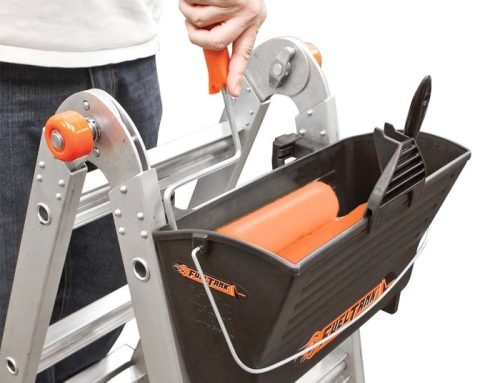Regular access to a rooftop requires a good ladder solution, usually a permanent fixing such as a cat ladder (a ladder with a cage around the higher portion that provides protection and something extra to hold on to) or fire escape. This image from California shows one of the worst permanent roof ladder ideas ever seen. The ladder is not fixed at all to the roof at the top, nor to the surface it is placed on. The bottom surface is another roof, which is not a good base surface for a ladder in the first place. There is a slope to this roof, making the placement of a ladder more precarious than if it was on a flat surface. The final thing that makes this roof ladder dangerous (as if there weren’t enough reasons already!) is that the only thing holding it in place is a wooden baton, nailed into the roof to provide a makeshift roof ladder stop. The rubbish piled up behind the ladder make it more dangerous to climb, as there is plenty to get your feet caught in and the pressure of the rubbish on the base of the ladder is really testing the baton holding the ladder in place.
Roof access ladders should never look like this one. Even as a makeshift solution this is fraught with bad and dangerous ideas and for a permanent roof access solution, well – words just fail us!
Ladders for Roof Access
If the need for roof access is maintenance, then a cat ladder fixed securely to the side of the building is the best bet. Tools can be carried on a tool belt or passed up via rope and these roof ladders are relied upon in many industrial applications. If there is a requirement for bigger machinery on the roof, then an external fire escape staircase is a good idea, as it serves not only as roof access, but an escape route as well. Cherry pickers and tall scaffold towers can also be employed to get people and equipment up onto the roof (if appropriate equipment training has been undertaken).
Roof Ladders for A Sloping Roof
The ideas above are ideal for access to flat roofs, but those with any kind of slope require a different kind of ladder to be used to reach the apex. Roof ladders come with wheels for extension up the roof as well as a sturdy hook that fixes over the top of the roof, keeping it secure. These roof ladders are not usually permanently fixed to the roof, but in cases where regular access is needed, they can be fixed, or a custom made roof ladder can be attached where needed.
Roof ladders are most often used by roofers (of course), electricians, surveyors, telecoms installers, satellite installers and builders. These people have a wealth of experience using roof ladders, as well as many other types of ladder, as they need to access the roof before the roof ladder can be deployed. Therefore, safety is paramount: there is a lot of training that should be undertaken before roof ladders can be used safely. Clearly, the person who installed the ‘roof ladder’ (note the quotes!) in California had no experience or training in ladder safety or best practice. We only hope that someone informed them of the dangers that this roof ladder poses before any serious harm was done.






Leave A Comment
You must be logged in to post a comment.